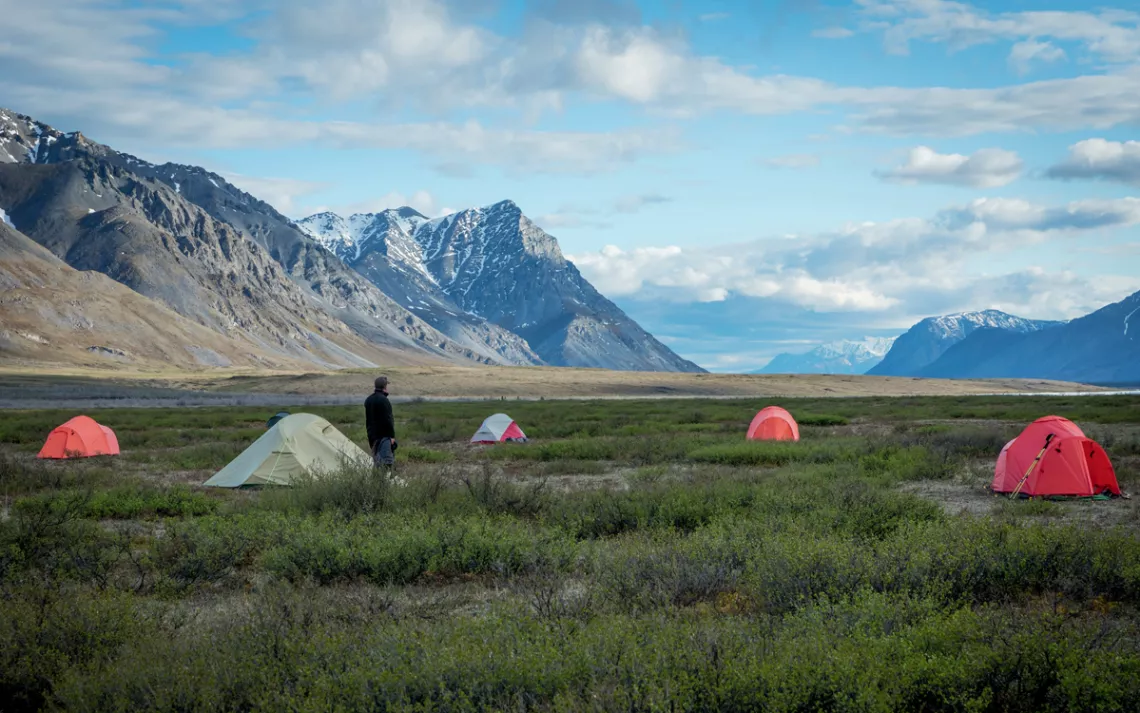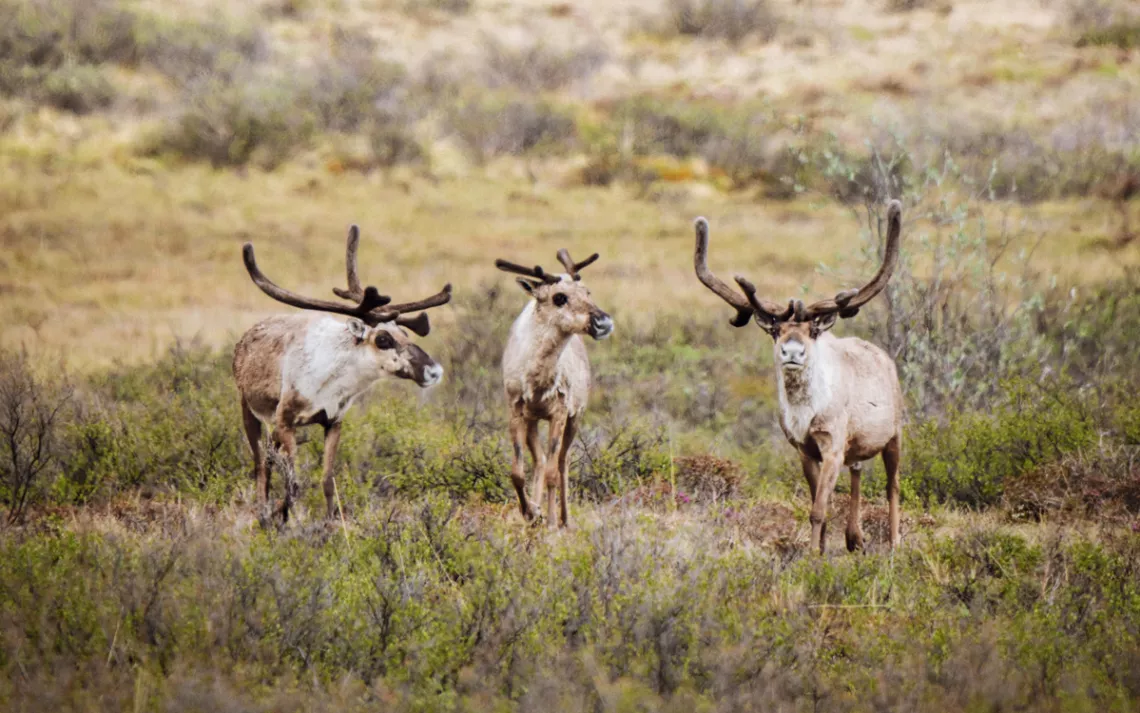Having Breakfast With Caribou in the Arctic National Wildlife Refuge
A short history of the Sierra Club's solidarity with the Gwich'in Nation

A Sierra Club campsite in Alaska's Brooks Range. | Photo by Ian Martin
Editor's note: On September 6, the Biden administration canceled the last seven oil and gas leases in the Arctic National Wildlife Refuge. The Interior Department also proposed new regulations for the National Petroleum Reserve, the nation's largest swath of public land, which would ban future oil and gas extraction across 10.6 million acres and add stronger protections to 2.4 million acres of the reserve. "To quote President Biden, this is a big f-ing deal. Oil and gas drilling in the Arctic Refuge is incompatible with the long-term survival of the Arctic, the Gwich’in Nation’s way of life, and life as we know it," Sierra Club executive director Ben Jealous said following the announcement. "By protecting these landscapes and canceling these leases, the White House has made it clear they will take bold action to avert climate catastrophe."
We came to the Arctic National Wildlife Refuge hoping to see caribou, and there they were: crossing the valley slopes in small bands, their coats rich and healthy, navigating the spongy tussocks with an even gait that spoke to a millennia-long history on the tundra.
Soon after the bush plane deposited us along the banks of the Chandalar River's east fork, we spotted the animals, some of them even passing close to our tents as we tried to sleep in the still-bright Arctic summer night. By the first breakfast, we were already so accustomed to their presence that it was possible to circle the camp chairs and get lost in a conversation about environmentalism. We did not talk about caribou, though. We talked about people.
There were seven of us in the group, including Chris Hill and Dan Ritzman from the Sierra Club's Our Wild America campaign and new-ish executive director Ben Jealous. Hill and Ritzman already knew the refuge well, but it was Jealous's first trip there since accepting the job last November. Before that, he served as president of People for the American Way, a progressive social justice organization, and before that, he was CEO of the National Association for the Advancement of Colored People.

Three members of the 200,000-strong Porcupine caribou herd.
It is an unusual résumé for someone heading America's largest grassroots environmental organization—but also fitting, as the past decade has been a time of change for both the Sierra Club and environmentalism as a whole. Within the organization and the broader movement, an awareness has grown that environmental goals must be pursued in tandem with social goals; that conservation has sometimes been pursued with less consideration for people than for nature; and that the protection of wilderness and wildness is inseparable from the well-being of people whose lives are already intertwined with it.
"If you want to build a mass movement, you have to meet people where they are. You need to understand what their interests are and how those interests might be advanced by us winning," Jealous said over breakfast. "We have a moral obligation to show that we can be good stewards of the local economy as well as the environment."
"Our Arctic way of life has endured for 20,000 years. Must we now die for 6 months of oil?"
Big words, delivered in a place where fossil corals from an ancient sea dotted the nearby riverbed and the surrounding mountains remained sharp from shearing by Ice Age glaciers. On the exposed slopes, lichen had only a tenuous hold; on the valley floor, it grew thick underfoot, enlivened by flowers just starting to bloom in the round-the-clock sunlight of early June.
There on the tundra, time—impermanence—was immediately evident. That gorgeous landscape had changed before and could change again. At this moment, though, when 8 billion human beings together exert a planet-shaping force, the potential for change resides less in tectonic shifts and planetary wobbles than in human activities.
Unfortunately, the calving grounds of the caribou—the Porcupine herd, to be precise, which is some 200,000 strong and has roamed the region for at least 27,000 years—sit above oil and gas deposits on the Beaufort Sea's verdant coastal plain. Those deposits have been the subject of a decades-long clash between fossil fuel extraction and environmental protection. Drilling would likely be catastrophic for the caribou.
That, in turn, would be disastrous for the Gwich'in, an Indigenous people whose traditional lands overlap with those of the caribou. The Gwich'in sometimes call the coastal plain "the sacred place where life begins," a testimony to the caribou's importance to them. The Gwich'in also call themselves "the caribou people."
On the way to the refuge, our group spent an evening in the Gwich'in town of Arctic Village. While there, we were escorted by a young man named Karlas Norman, who took us to the town's church. Inside hung historical photographs of the community and a framed copy of a full-page advertisement that ran in The New York Times in 1991.
The ad—as relevant now as when it was published—features a portrait of a Gwich'in man, several caribou, and a child in traditional dress beneath the words "Our Arctic way of life has endured for 20,000 years. Must we now die for 6 months of oil?" Six months is the time it would take for the United States to consume the coastal plain's deposits.
"Our caribou are our main source of food," Norman said. I asked what the caribou meant to him. "It would be everything," he replied. "But to put it in one word? It would be . . . savior."
The Sierra Club has long been in solidarity with the Gwich'in, most recently partnering in a campaign to dissuade banks from funding oil and gas extraction after the Trump administration opened the coastal plain to drilling. Jealous had come to Arctic Village to introduce himself, to begin building relationships. "We need to be careful that the work we do is tied into achieving the economy that they're trying to create," Jealous said later at our tundra breakfast as talk turned to earlier discussions with the Gwich'in. "My conversation with Karlas was, 'What do you need, and what do you want to do?'"
Our group also met with Sarah James, a Gwich'in elder, who served a feast of caribou and fry bread—the latter prepared in both the local fashion and according to a recipe she had learned from a Navajo friend at the Bureau of Indian Affairs boarding school to which she was sent as a teenager. James reminisced about the 1969–71 occupation of Alcatraz, a landmark event in the Native American resurgence, and about the 1988 gathering when members of the Gwich'in's scattered communities met in Arctic Village to pledge their opposition to drilling and their commitment to protecting the caribou.
"It was like a rebirth of the nation," she recalled. "They said, 'We're going to make the decision for the seventh generation.' And then we had to stay united."
Earlier, I had ridden on the back of James's four-wheeler as she picked up soup for dinner. On the way, I asked whether, after all these decades of struggle, with the possibility of drilling on the coastal plain still looming over the caribou and the Gwich'in and their way of life, she worried that they might lose. She did not. "There's too many of us," James said. Altogether there are about 6,000 Gwich'in, but that's not what she meant. "We made too many friends."
 The Magazine of The Sierra Club
The Magazine of The Sierra Club



